前几天博主接到一个任务:5台HTCVIVEPro设备,其中一台设备进行演示,另外四台设备画面同步。
在设备没到之前,博主进行了一下前期准本工作:同一局域网 一台主机控制多台主机
PS:博主参考了其它博主大大的文章,感觉很有用!!!!!!
如果需要其它的一些TCP操作流程,请看这个博主大大的文章,很详细
【Unity】Socket网络通信(TCP) - 最基础的C#服务端通信流程_unity的tcp发送消息_IM雾凇的博客-CSDN博客
【Unity】Socket网络通信(TCP) - 实现简单的多人聊天功能_unity socket通信_IM雾凇的博客-CSDN博客
以下开始了博主操作的具体流程,希望对你有所帮助
一:5台设备同一局域网下,且所有主机的防火墙需要关闭,要保证每台电脑都能互相ping通
1.如何关闭防火墙:
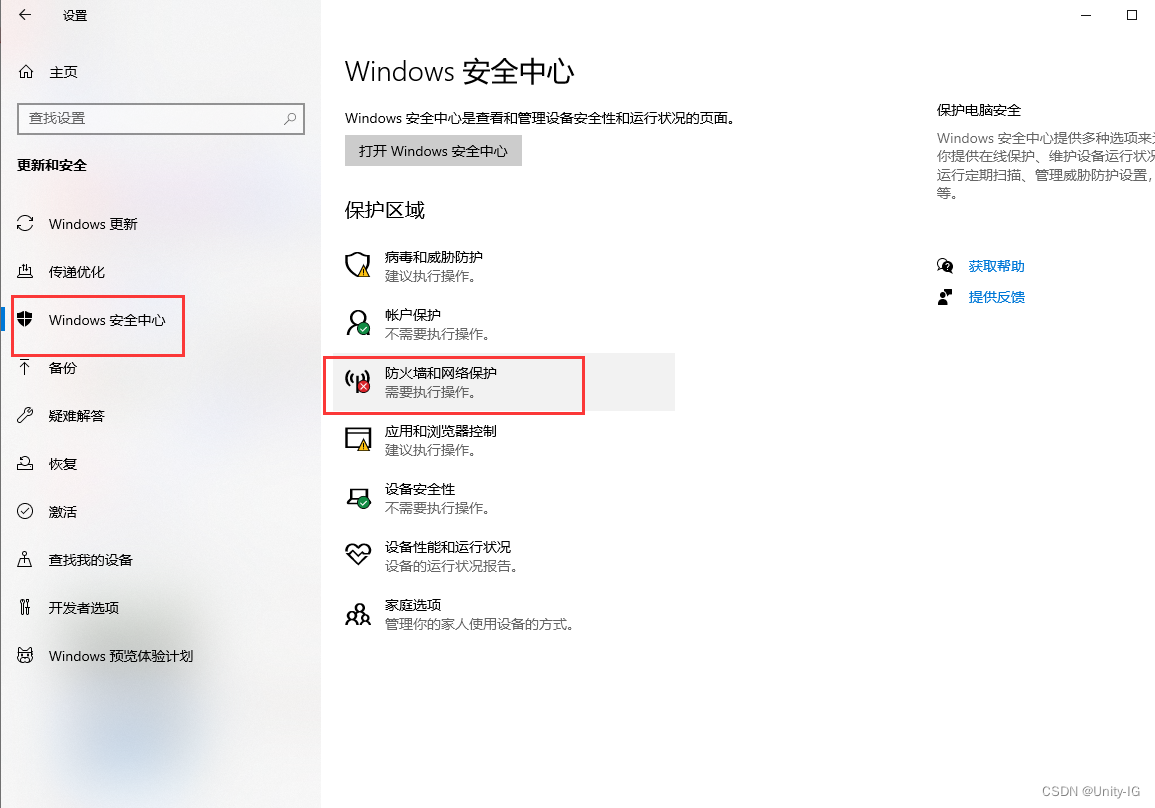
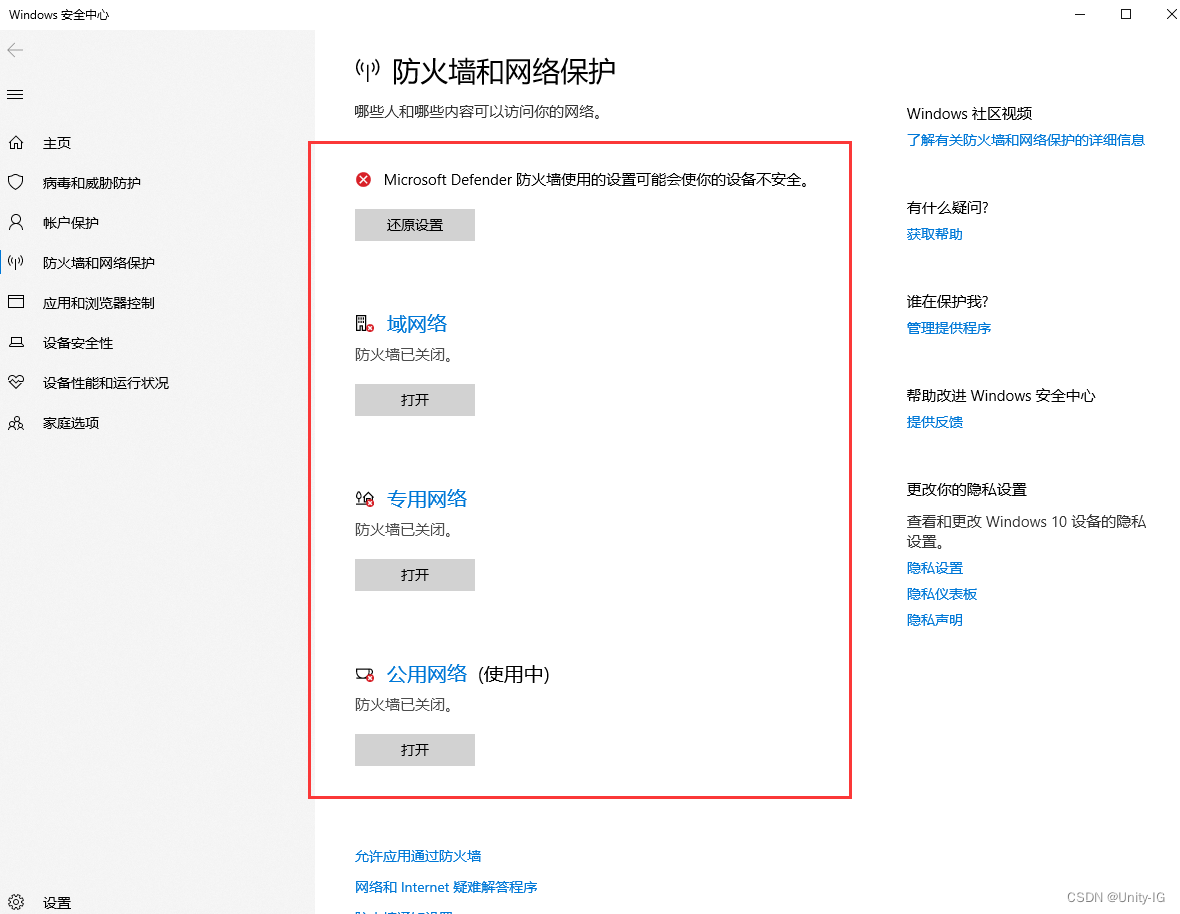
2.ping他人电脑
win+R打开cmd, ping 192.168.2.5 按下enter键之后,出现数据即为ping通
二.创建服务器,我们需要一台主机作为服务器(消息发送方)
1.打开VS,创建控制台应用程序
2.封装服务端ServerSocket
using System;
using System.Collections.Generic;
using System.Net;
using System.Net.Sockets;
using System.Text;
using System.Threading;
namespace TCPServer
{
public class ServerSocket
{
private Socket socket;
private bool isClose;
private List<ClientSocket> clientList = new List<ClientSocket>();
public void Start(string ip, int port, int clientNum)
{
isClose = false;
socket = new Socket(AddressFamily.InterNetwork, SocketType.Stream, ProtocolType.Tcp);
IPEndPoint iPEndPoint = new IPEndPoint(IPAddress.Parse(ip), port);
socket.Bind(iPEndPoint);
Console.WriteLine("服务器启动成功...IP:{0},端口:{1}", ip, port);
Console.WriteLine("开始监听客户端连接...");
socket.Listen(clientNum);
ThreadPool.QueueUserWorkItem(AcceptClientConnect);
ThreadPool.QueueUserWorkItem(ReceiveMsg);
}
/// <summary>
/// 等待客户端连接
/// </summary>
/// <param name="obj"></param>
private void AcceptClientConnect(object obj)
{
Console.WriteLine("等待客户端连入..."+ (!isClose));
while (!isClose)
{
Socket clientSocket = socket.Accept();
ClientSocket client = new ClientSocket(clientSocket, this);
Console.WriteLine("客户端{0}连入...", clientSocket.RemoteEndPoint.ToString());
client.SendMsg(Encoding.UTF8.GetBytes("欢迎连入服务端..."));
clientList.Add(client);
}
}
/// <summary>
/// 接收消息
/// </summary>
/// <param name="obj"></param>
private void ReceiveMsg(object obj)
{
int i;
while (!isClose)
{
if (clientList.Count > 0)
{
for(i = 0; i < clientList.Count; i++)
{
try
{
clientList[i].ReceiveClientMsg();
}
catch(Exception e)
{
Console.WriteLine(e.Message);
}
}
}
}
}
/// <summary>
/// 发送消息
/// </summary>
/// <param name="msg"></param>
/// <param name="clientID"></param>
public void BroadcastMsg(byte[] msg, int clientID)
{
if (isClose)
return;
for(int i = 0; i < clientList.Count; i++)
{
if (clientList[i].clientID != clientID)
{
clientList[i].SendMsg(msg);
}
}
}
/// <summary>
/// 释放连接
/// </summary>
public void Close()
{
isClose = true;
for(int i = 0; i < clientList.Count; i++)
{
clientList[i].Close();
}
clientList.Clear();
socket.Shutdown(SocketShutdown.Both);
socket.Close();
socket = null;
}
}
}
3.封装客户端连入时返回的ClientSocket
using System;
using System.Net.Sockets;
using System.Text;
using System.Threading;
namespace TCPServer
{
public class ClientSocket
{
public static int CLIENT_BEGIN_ID = 1;
public int clientID;
public string IP;
private Socket socket;
private ServerSocket serverSocket;
public ClientSocket(Socket clientSocket, ServerSocket serverSocket)
{
socket = clientSocket;
this.serverSocket = serverSocket;
IP = clientSocket.RemoteEndPoint.ToString();
clientID = CLIENT_BEGIN_ID;
++CLIENT_BEGIN_ID;
}
/// <summary>
/// 发送消息
/// </summary>
/// <param name="msg"></param>
public void SendMsg(byte[] msg)
{
if(socket != null)
socket.Send(msg);
}
/// <summary>
/// 接收消息
/// </summary>
public void ReceiveClientMsg()
{
if (socket == null)
return;
if(socket.Available > 0)
{
byte[] msgBytes = new byte[1024*1024];
int msgLength = socket.Receive(msgBytes);
byte[] tempMsg = new byte[msgLength];
Buffer.BlockCopy(msgBytes, 0, tempMsg, 0, msgLength);
serverSocket.BroadcastMsg(tempMsg, clientID);
}
}
/// <summary>
/// 释放连接
/// </summary>
public void Close()
{
socket.Shutdown(SocketShutdown.Both);
socket.Close();
socket = null;
}
}
}
3.主函数,用来读取配置文件的IP,以及传参,(配置文件我在这里放到了C盘,因为考虑到开机自启的项目,文件格式txt的)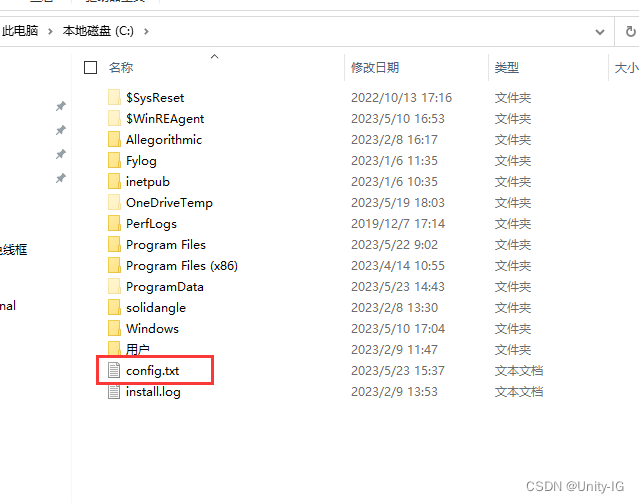
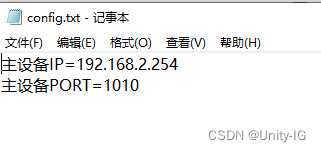
using System;
using System.IO;
using System.Text;
namespace TCPServer
{
class Program
{
private static ServerSocket serverSocket;
static void Main(string[] args)
{
string path = @"C:\config.txt";
string IP = "127.0.0.1";
int PORT = 8080;
if (File.Exists(path))
{
string[] str = File.ReadAllLines(path);
if (str[0].StartsWith("主设备IP"))
{
IP = str[0].Split('=')[1];
}
if (str[1].StartsWith("主设备PORT"))
{
PORT = int.Parse(str[1].Split('=')[1]);
}
}
serverSocket = new ServerSocket();
serverSocket.Start(IP, PORT, 1024);
while (true)
{
string inputStr = Console.ReadLine();
if (inputStr == "Quit")
{
serverSocket.Close();
break;
}
else if (inputStr.Substring(0, 2) == "B:")
{
Console.WriteLine("发送..." + inputStr.Substring(2));
serverSocket.BroadcastMsg(Encoding.UTF8.GetBytes(inputStr.Substring(2)), -1);
}
}
}
}
}
4.打包控制台.exe运行程序(详细步骤请看这位大大的博客,按照方法二即可)
C# 控制台程序的开发和打包为一个exe文件_c# 生成exe_西凉的悲伤的博客-CSDN博客
这是我打包之后的文件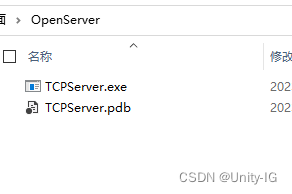
三,开始搭建五台设备客户端Unity运行程序
1.搭建如下图UI界面,并在父物体上挂载脚本MainManager.cs
备注:
1.主控制机既是服务器又是客户端;
2.主控制机作为发送方发送指令到另外4台主机上
3.另外4台设备只负责接收指令即可
4.需要把上述配置文件config.txt复制一份放在Asset目录下的StreamingAssets文件夹里(因为客户端需要连接服务器,金主爸爸们的主机IP我们也不晓得,只能做配置文件啦)
PS:在Mainmaneger这里我做了一个判断,若当前运行程序的主机IP与服务器IP一致,那么即为发送方;反之即为接收方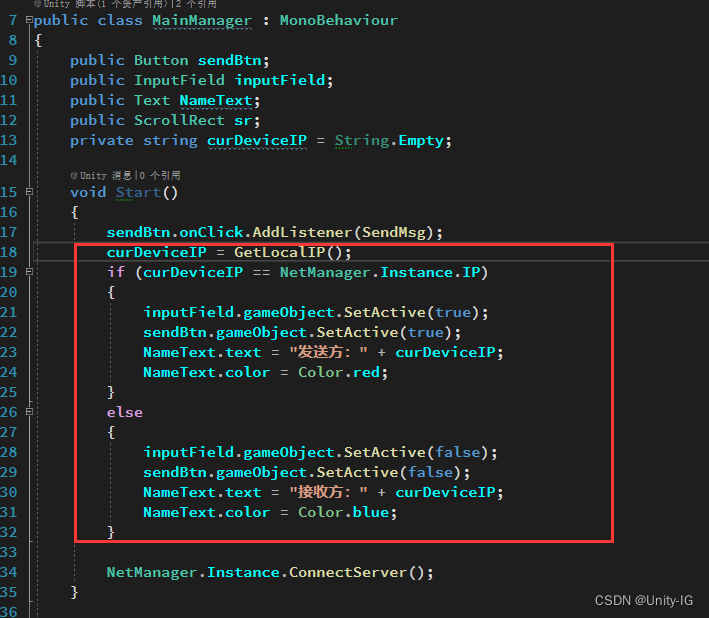
PS:如何获取本地主机的IP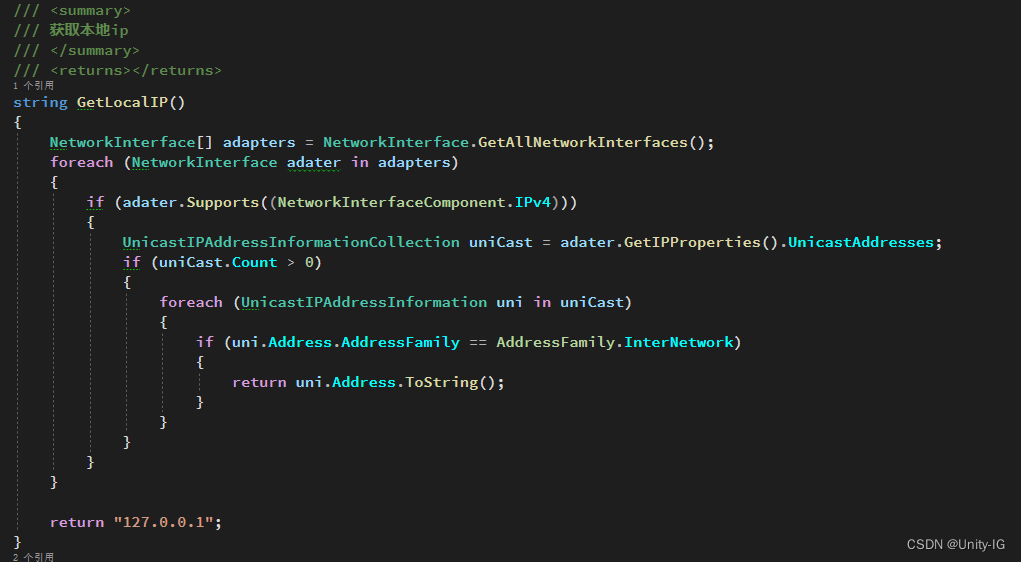
下面直接上MainManager代码:
using System;
using System.Net.NetworkInformation;
using System.Net.Sockets;
using UnityEngine;
using UnityEngine.UI;
public class MainManager : MonoBehaviour
{
public Button sendBtn;
public InputField inputField;
public Text NameText;
public ScrollRect sr;
private string curDeviceIP = String.Empty;
void Start()
{
sendBtn.onClick.AddListener(SendMsg);
curDeviceIP = GetLocalIP();
if (curDeviceIP == NetManager.Instance.IP)
{
inputField.gameObject.SetActive(true);
sendBtn.gameObject.SetActive(true);
NameText.text = "发送方:" + curDeviceIP;
NameText.color = Color.red;
}
else
{
inputField.gameObject.SetActive(false);
sendBtn.gameObject.SetActive(false);
NameText.text = "接收方:" + curDeviceIP;
NameText.color = Color.blue;
}
NetManager.Instance.ConnectServer();
}
// Update is called once per frame
void Update()
{
}
void SendMsg()
{
if (inputField.text != "")
{
ChatMsg chatMsg = new ChatMsg();
chatMsg.chatStr = inputField.text;
NetManager.Instance.Send<ChatMsg>(chatMsg);
UpdateChatInfo(chatMsg);
inputField.text = "";
}
}
/// <summary>
/// 获取本地ip
/// </summary>
/// <returns></returns>
string GetLocalIP()
{
NetworkInterface[] adapters = NetworkInterface.GetAllNetworkInterfaces();
foreach (NetworkInterface adater in adapters)
{
if (adater.Supports((NetworkInterfaceComponent.IPv4)))
{
UnicastIPAddressInformationCollection uniCast = adater.GetIPProperties().UnicastAddresses;
if (uniCast.Count > 0)
{
foreach (UnicastIPAddressInformation uni in uniCast)
{
if (uni.Address.AddressFamily == AddressFamily.InterNetwork)
{
return uni.Address.ToString();
}
}
}
}
}
return "127.0.0.1";
}
public void UpdateChatInfo(ChatMsg msgInfo)
{
Text chatInfoText = Instantiate(Resources.Load<Text>("UI/MsgInfoText"), sr.content);
chatInfoText.text = NameText.text + ":" + msgInfo.chatStr;
}
}
2.创建NetManager.cs用来连接服务器等
在这里需注意连接服务器时的IP和PORT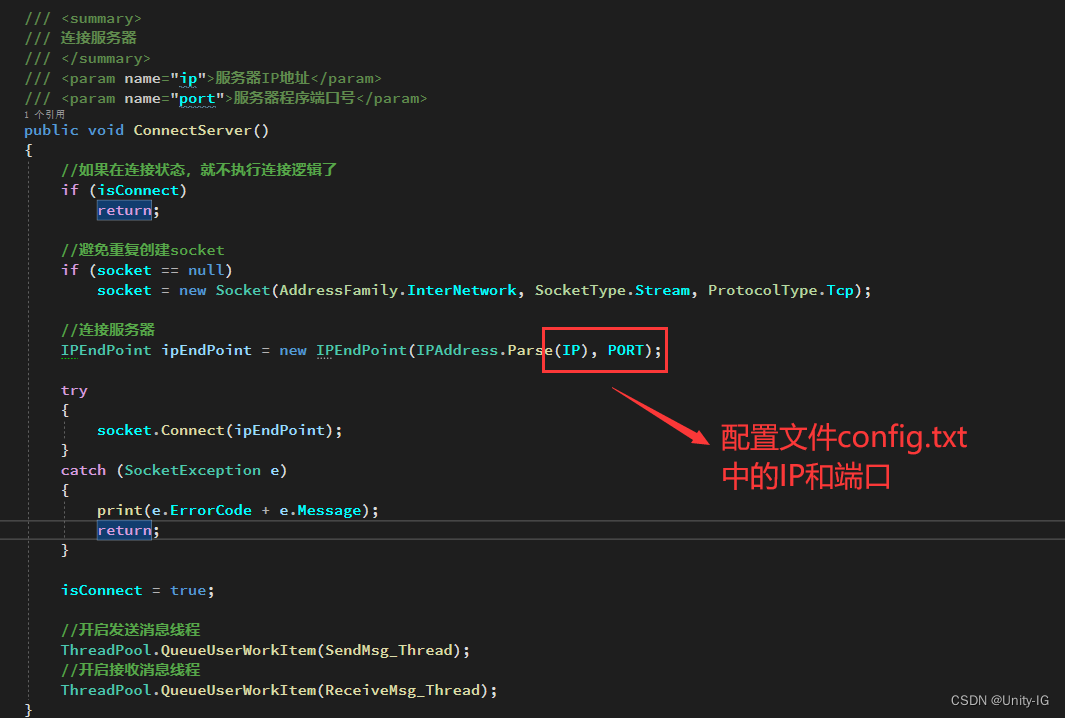
直接上NetManager.cs代码
using System.Collections;
using System.Collections.Generic;
using System.Net;
using System.Net.Sockets;
using System.Text;
using System.Threading;
using UnityEngine;
using System;
using System.IO;
using System.Net.NetworkInformation;
public class NetManager : MonoBehaviour
{
public static NetManager Instance => instance;
private static NetManager instance;
private Socket socket;
private bool isConnect;
private Queue<byte[]> sendQueue = new Queue<byte[]>();
private Queue<byte[]> receiveQueue = new Queue<byte[]>();
private byte[] receiveBytes = new byte[1024 * 1024];
private MainManager mainManager;
public string path = String.Empty;
public string IP = String.Empty;
public int PORT = 8080;
private void Awake()
{
if (instance == null)
{
instance = this;
DontDestroyOnLoad(gameObject);
}
path = Application.streamingAssetsPath + "/config.txt";
IP = "127.0.0.1";
PORT = 8080;
if (File.Exists(path))
{
string[] str = File.ReadAllLines(path);
if (str[0].StartsWith("主设备IP"))
{
IP = str[0].Split('=')[1];
}
if (str[1].StartsWith("主设备PORT"))
{
PORT = int.Parse(str[1].Split('=')[1]);
}
}
}
private void Start()
{
GameObject chatPanelObj = GameObject.Find("MainManager");
mainManager = chatPanelObj.GetComponent<MainManager>();
}
// Update is called once per frame
void Update()
{
if (receiveQueue.Count > 0)
{
ReadingMsgType(receiveQueue.Dequeue());
}
}
/// <summary>
/// 连接服务器
/// </summary>
/// <param name="ip">服务器IP地址</param>
/// <param name="port">服务器程序端口号</param>
public void ConnectServer()
{
//如果在连接状态,就不执行连接逻辑了
if (isConnect)
return;
//避免重复创建socket
if (socket == null)
socket = new Socket(AddressFamily.InterNetwork, SocketType.Stream, ProtocolType.Tcp);
//连接服务器
IPEndPoint ipEndPoint = new IPEndPoint(IPAddress.Parse(IP), PORT);
try
{
socket.Connect(ipEndPoint);
}
catch (SocketException e)
{
print(e.ErrorCode + e.Message);
return;
}
isConnect = true;
//开启发送消息线程
ThreadPool.QueueUserWorkItem(SendMsg_Thread);
//开启接收消息线程
ThreadPool.QueueUserWorkItem(ReceiveMsg_Thread);
}
/// <summary>
/// 发送消息
/// </summary>
/// <typeparam name="T"></typeparam>
/// <param name="msg"></param>
public void Send<T>(T msg) where T : BaseMsg
{
//将消息放入到消息队列中
sendQueue.Enqueue(msg.SerializeData());
}
private void SendMsg_Thread(object obj)
{
while (isConnect)
{
//如果消息队列中有消息,则发送消息
if (sendQueue.Count > 0)
{
socket.Send(sendQueue.Dequeue());
}
}
}
/// <summary>
/// 接收消息
/// </summary>
/// <param name="obj"></param>
private void ReceiveMsg_Thread(object obj)
{
int msgLength;
while (isConnect)
{
if (socket.Available > 0)
{
msgLength = socket.Receive(receiveBytes);
receiveQueue.Enqueue(receiveBytes);
}
}
}
private void ReadingMsgType(byte[] msg)
{
int msgId = BitConverter.ToInt32(msg, 0);
switch (msgId)
{
case 1001:
ReadingChatMsg(msg);
break;
}
}
private void ReadingChatMsg(byte[] msg)
{
ChatMsg chatMsg = new ChatMsg();
chatMsg.ReadingData(msg, 4);
mainManager.UpdateChatInfo(chatMsg);
}
public void Close()
{
if (socket != null && isConnect)
{
socket.Shutdown(SocketShutdown.Both);
socket.Close();
isConnect = false;
}
}
private void OnDestroy()
{
Close();
}
}
以上是两个主要的函数,其它的可自行看下方源文件
运行顺序:先打开服务器,在每台电脑上依次打开unity运行程序即可。
下面是我最终的运行效果图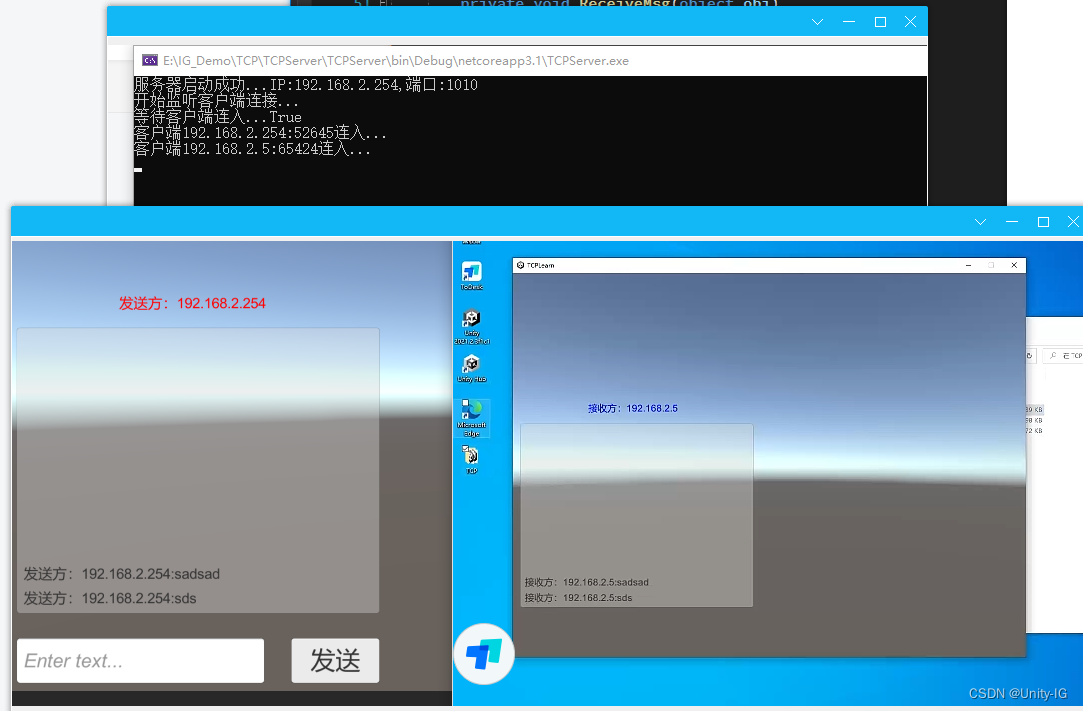
源文件链接:链接:https://pan.baidu.com/s/1pTwGj37ozMlq58OHcIJPIg
提取码:1234
--来自百度网盘超级会员V5的分享
https://gitee.com/various-tool-scripts/tcptest.git![]() https://gitee.com/various-tool-scripts/tcptest.git谨以此文记录博主自己的个人历程,希望对大家有所帮助
https://gitee.com/various-tool-scripts/tcptest.git谨以此文记录博主自己的个人历程,希望对大家有所帮助